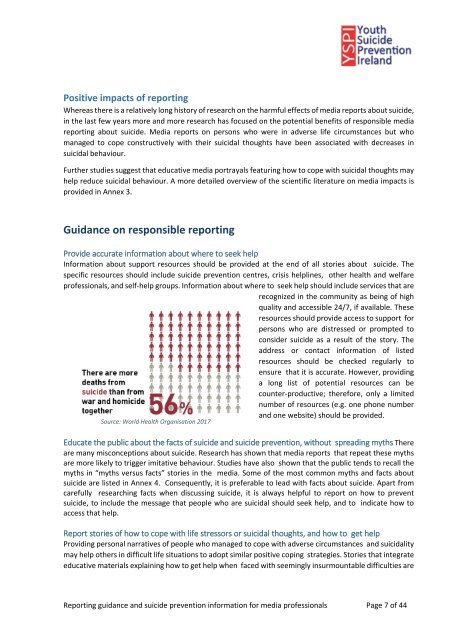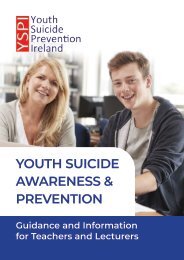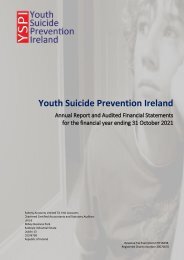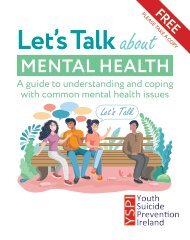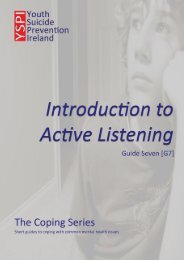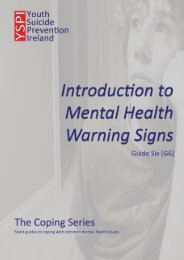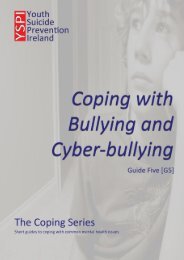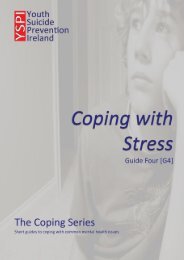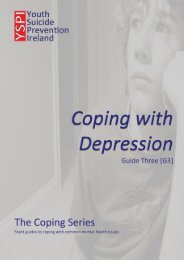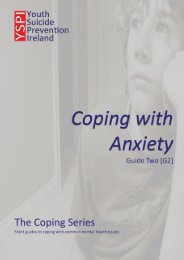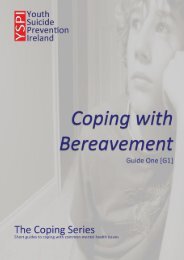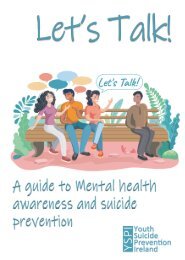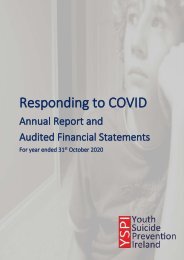Create successful ePaper yourself
Turn your PDF publications into a flip-book with our unique Google optimized e-Paper software.
Positive impacts of reporting<br />
Whereas there is a relatively long history of research on the harmful effects of media reports about suicide,<br />
in the last few years more <strong>and</strong> more research has focused on the potential benefits of responsible media<br />
reporting about suicide. <strong>Media</strong> reports on persons who were in adverse life circumstances but who<br />
managed to cope constructively with their suicidal thoughts have been associated with decreases in<br />
suicidal behaviour.<br />
Further studies suggest that educative media portrayals featuring how to cope with suicidal thoughts may<br />
help reduce suicidal behaviour. A more detailed overview of the scientific literature on media impacts is<br />
provided in Annex 3.<br />
<strong>Guidance</strong> on responsible reporting<br />
Provide accurate in<strong>for</strong>mation about where to seek help<br />
<strong>In<strong>for</strong>mation</strong> about support resources should be provided at the end of all stories about suicide. The<br />
specific resources should include suicide prevention centres, crisis helplines, other health <strong>and</strong> welfare<br />
professionals, <strong>and</strong> self-help groups. <strong>In<strong>for</strong>mation</strong> about where to seek help should include services that are<br />
recognized in the community as being of high<br />
quality <strong>and</strong> accessible 24/7, if available. These<br />
resources should provide access to support <strong>for</strong><br />
persons who are distressed or prompted to<br />
consider suicide as a result of the story. The<br />
address or contact in<strong>for</strong>mation of listed<br />
resources should be checked regularly to<br />
ensure that it is accurate. However, providing<br />
a long list of potential resources can be<br />
counter-productive; there<strong>for</strong>e, only a limited<br />
number of resources (e.g. one phone number<br />
<strong>and</strong> one website) should be provided.<br />
Source: World Health Organisation 2017<br />
Educate the public about the facts of suicide <strong>and</strong> suicide prevention, without spreading myths There<br />
are many misconceptions about suicide. Research has shown that media reports that repeat these myths<br />
are more likely to trigger imitative behaviour. Studies have also shown that the public tends to recall the<br />
myths in “myths versus facts” stories in the media. Some of the most common myths <strong>and</strong> facts about<br />
suicide are listed in Annex 4. Consequently, it is preferable to lead with facts about suicide. Apart from<br />
carefully researching facts when discussing suicide, it is always helpful to report on how to prevent<br />
suicide, to include the message that people who are suicidal should seek help, <strong>and</strong> to indicate how to<br />
access that help.<br />
Report stories of how to cope with life stressors or suicidal thoughts, <strong>and</strong> how to get help<br />
Providing personal narratives of people who managed to cope with adverse circumstances <strong>and</strong> suicidality<br />
may help others in difficult life situations to adopt similar positive coping strategies. Stories that integrate<br />
educative materials explaining how to get help when faced with seemingly insurmountable difficulties are<br />
<strong>Reporting</strong> guidance <strong>and</strong> suicide prevention in<strong>for</strong>mation <strong>for</strong> media professionals Page 7 of 44


